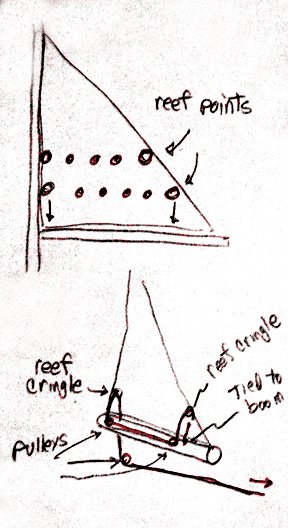 Yesterday I finally rigged the reefing for my mainsail. Reefing is lowering the sail part way so it doesn’t present so much area to the wind…especially useful in strong storms where the sail needs to be ‘depowered’ to avoid going too fast…or more likely, blowing over. Jiffy reefing is simply a way to make this lowering easier to do…even from the safety of the cockpit, since one usually wishes the sails were reefed just at the time when the wind is so strong you fear getting washed off the deck if you go forward!
Yesterday I finally rigged the reefing for my mainsail. Reefing is lowering the sail part way so it doesn’t present so much area to the wind…especially useful in strong storms where the sail needs to be ‘depowered’ to avoid going too fast…or more likely, blowing over. Jiffy reefing is simply a way to make this lowering easier to do…even from the safety of the cockpit, since one usually wishes the sails were reefed just at the time when the wind is so strong you fear getting washed off the deck if you go forward!
Jiffy reefing is a clever arrangement of light lines (ropes) and blocks (pulleys for you landlubbers) which make it easier to bring the mainsail down to just the right place to tie off the sail at the preset place(s). From the drawing you can see that it requires 3 pulleys and a rope that is fed through the reef cringles (large grommeted holes at the ends of the reef line). When the halyard…the rope attached to the top of the sail that holds it up…is let loose a bit, the sail starts to loosen and drop down. By pulling on the jiffy reefing line the two cringles are pulled down to the boom, holding the sail at the desired height. Then the halyard is tightened so the exposed area of the sail is tight again and the reef lines strung through the holes between the cringles can…if the winds and your courage allow…be tied around the bottom of the boom so the center of the sail stays tight against the boom and the excess sail doesn’t flop around. If it has become dangerously windy, you can leave those lines untied. Interestingly enough, the name for the ‘square knot’ in nautical terms is the ‘reef knot’ because it is the best knot to use for tying off those ropes.
While jiffy reefing makes the process considerably easier…especially when done by a single person…it is always best to anticipate the need to reduce sail before the conditions make it too difficult. I usually gauge the wind before starting out and do reefing and choosing a smaller jib while the boat is safely in the harbor, needing no one at the helm.

Norm Lehman writes: Sadly, she is unlkleiy to survive her first encounter with anything of substance a whale, a ship, a reef. Sad is only that the imagination of so many people is restricted to their own limited possibilities and their own limited lifetime. (Our planet could have some less problems if that was not so. But don’t worry Windvinder is working on it )Every single part of this unmanned boat bears instructions for the people who will find it in the middle of the ocean or somewhere on a reef, the words burned into the wood of the skeleton, translated into more than 45 languages. Finders are asked to help: to repair and rebuild the boat, to make it better and stronger. And, believe it or not there are people who really do this. Not for me, and not for money, but WHY THEN that’s one of the questions of the expedition to Where the wind comes from.This voyage will still be going on after you, and me, and the Ur-Windvinder, have long ceased to exist. This is the life journey of a species, not of an individual: A voyage of discovery that goes further than anything I could possibly imagine beforehand and further than any single boat could go in it’s lifetime, however sturdily it was built.A 100-ton-expedition vessel would end up on the same reef as the Windvinder. Only, no normal person could ever repair it.That’s why Windvinder is such a small scale boat for such a global expedition. He is mercurial and transitory, he cannot be held and cannot be steered. This is his strength.He cannot be grasped by any force that wants to stop him. Instead, he uses that force to get further:HE LIVES ON HEADWINDS !The whale, the ship and the reef are necessary parts of Windvinder’s voyage.They have to add substance to this featherlight being which has just been born.Wipke Iwersen,Windvinder